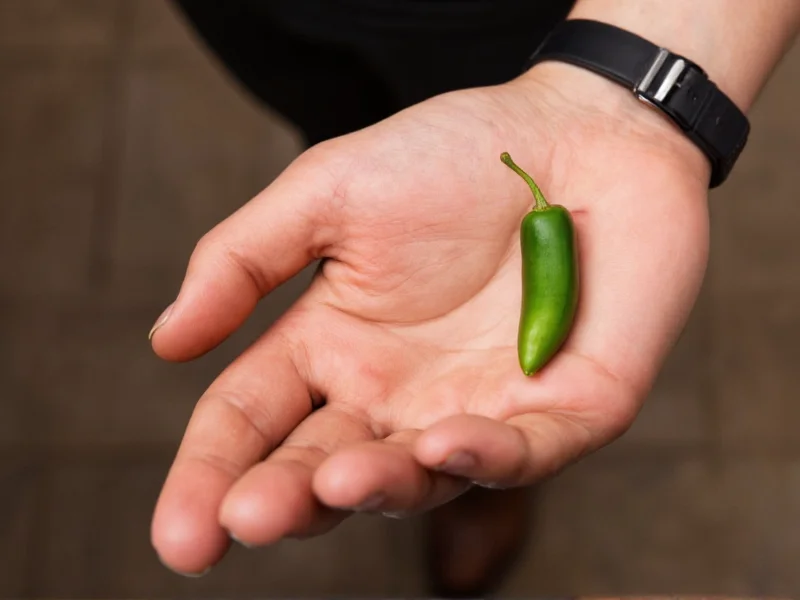Why Jalapeños Cause Burning Sensations on Skin
When you handle jalapeño peppers, you're exposed to capsaicin—the compound responsible for their heat. Capsaicin is an oil-based substance that binds to TRPV1 receptors in your skin, triggering a burning sensation that can last for hours. Unlike water-soluble irritants, capsaicin doesn't wash away with water alone, which is why the burn persists even after washing your hands.
Step-by-Step Relief Methods for Jalapeño Burns
Understanding how to properly address jalapeño burns can provide significant relief. Here's what to do immediately after exposure:
- Wash with soap and cold water: Use a degreasing soap to break down the oil-based capsaicin. Hot water opens pores and increases absorption.
- Apply an oil-based solution: Vegetable oil, olive oil, or even peanut butter can dissolve the capsaicin oil through "like dissolves like" chemistry.
- Try dairy products: Milk, yogurt, or sour cream contain casein that helps break down capsaicin molecules.
- Use alcohol-based solutions: Rubbing alcohol or high-proof vodka can help dissolve the oils before washing again with soap.
- Apply baking soda paste: For residual burning, a paste of baking soda and cold water can help neutralize the sensation.
| Remedy | Effectiveness | Time to Relief | Notes |
|---|---|---|---|
| Vegetable oil | ★★★★☆ | 2-5 minutes | Most accessible household item for immediate relief |
| Milk or dairy | ★★★★☆ | 3-7 minutes | Casein protein breaks down capsaicin effectively |
| Rubbing alcohol | ★★★☆☆ | 5-10 minutes | Use before soap washing; may cause temporary stinging |
| Baking soda paste | ★★☆☆☆ | 10-15 minutes | Good for residual burning after initial treatment |
| Water alone | ★☆☆☆☆ | Little to no relief | Worsens burn if hot; ineffective as capsaicin is oil-based |
What NOT to Do When Your Hands Burn from Jalapeños
Certain common reactions can actually worsen jalapeño burns:
- Don't use hot water: Heat opens pores and allows more capsaicin to penetrate your skin
- Avoid touching your face: Capsaicin transfer to eyes or mouth causes severe burning
- Don't rub your hands: Spreads the oil to unaffected areas
- Skip vinegar solutions: Despite popular belief, vinegar doesn't effectively neutralize capsaicin
Preventing Jalapeño Burns During Food Preparation
Prevention is always better than treatment when handling hot peppers:
- Wear disposable nitrile gloves (latex offers less protection against oils)
- Apply a thin layer of vegetable oil to hands before handling peppers
- Use dedicated cutting boards for spicy ingredients
- Wash all surfaces with soapy water after preparation
- Consider using kitchen shears instead of hands for stem removal
When to Seek Medical Attention for Pepper Burns
Most jalapeño burns resolve with home treatment, but consult a healthcare provider if you experience:
- Severe blistering or skin damage
- Burning that persists beyond 24 hours despite proper treatment
- Signs of infection (increased redness, swelling, pus)
- Accidental transfer to eyes causing vision changes
- Extreme pain that interferes with daily activities
Understanding Capsaicin Chemistry for Better Relief
The effectiveness of different remedies depends on understanding capsaicin's chemical properties. As an alkaloid with both hydrophobic (oil-loving) and hydrophilic properties, capsaicin requires specific approaches for removal. Oil-based solutions work through solubility principles—"like dissolves like"—while dairy products leverage casein's ability to bind with capsaicin molecules. Alcohol solutions work by breaking the hydrogen bonds that help capsaicin adhere to skin receptors.
Long-Term Management of Jalapeño Sensitivity
Some people develop increased sensitivity to capsaicin with repeated exposure. If you frequently handle hot peppers:
- Consider building tolerance gradually with milder peppers first
- Use barrier creams containing dimethicone before handling
- Keep a dedicated "pepper kit" with gloves and cleaning supplies
- Wash hands with Dawn dish soap, which has strong degreasing properties
How long does jalapeno burn typically last on skin?
With proper treatment, most jalapeno burns subside within 30-60 minutes. Without treatment, the burning sensation can persist for 2-8 hours as capsaicin gradually dissipates. Complete resolution typically occurs within 24 hours for most people.
Can I use vinegar to treat jalapeno burns on my hands?
Vinegar is generally ineffective for treating jalapeno burns. Since capsaicin is oil-based rather than alkaline, acidic solutions like vinegar don't neutralize it effectively. Oil-based solutions or dairy products work better by dissolving or binding with the capsaicin molecules.
Why does milk help with jalapeno burns?
Milk helps with jalapeno burns because it contains casein, a protein that binds to capsaicin molecules and helps wash them away. The fat content in whole milk also helps dissolve the oil-based capsaicin. For best results, use cold whole milk or soak hands in plain yogurt.
What's the best way to prevent jalapeno burns when gardening?
When gardening with hot peppers, wear nitrile gloves (not latex) and long sleeves. Apply a thin layer of vegetable oil to exposed skin areas before working. After harvesting, wash all tools and clothing separately. Consider using pepper-proof gardening gloves designed specifically for handling hot peppers.
Can jalapeno burns cause permanent damage to skin?
Jalapeno burns typically don't cause permanent skin damage. The burning sensation comes from temporary stimulation of nerve receptors, not actual tissue damage. However, excessive rubbing or improper treatment could lead to skin irritation or secondary infection. Severe reactions are rare but possible in individuals with extreme sensitivity.











 浙公网安备
33010002000092号
浙公网安备
33010002000092号 浙B2-20120091-4
浙B2-20120091-4